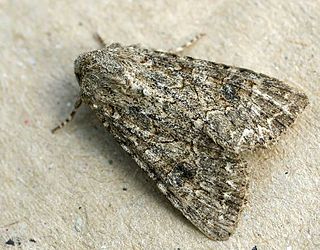
The Noctuidae, commonly known as owlet moths, cutworms or armyworms, are the most controversial family in the superfamily Noctuoidea because many of the clades are constantly changing, along with the other families of the Noctuoidea. It was considered the largest family in Lepidoptera for a long time, but after regrouping Lymantriinae, Catocalinae and Calpinae within the family Erebidae, the latter holds this title now. Currently, Noctuidae is the second largest family in Noctuoidea, with about 1,089 genera and 11,772 species. However, this classification is still contingent, as more changes continue to appear between Noctuidae and Erebidae.

The Drepanidae is a family of moths with about 660 species described worldwide. They are generally divided in three subfamilies which share the same type of hearing organ. Thyatirinae, previously often placed in their own family, bear a superficial resemblance to Noctuidae. Many species in the Drepanid family have a distinctively hook-shaped apex to the forewing, leading to their common name of hook-tips.

The true lover's knot is a moth of the family Noctuidae. The species was first described by Michael Denis and Ignaz Schiffermüller in 1775. It is found in the west Palearctic in a wide band through northern, central and eastern Europe and Russia. In the south it is spread through northern Spain and northern Portugal, northern Italy, Macedonia, Bulgaria, and northern Greece. In Europe it is found wherever its food plants grow. It is traditionally thought of as a species typical of heathland and moorland but it can often be found in places where heather and its relatives are in garden cultivation. In the mountains it is found up to an elevation of over 2000 metres above sea level.

The Noctuinae are a subfamily of the family Noctuidae. The larvae of many species feed on roots or stems of various grasses. Some are generalist feeders which makes them potential pests.

Hadeninae is a subfamily of moth family Noctuidae. The limits between this group and the Condicinae and Noctuinae are still not precisely known, with 3 major and partially conflicting revisions since 2006. Some include the noctuid subfamilies Eriopinae and Psaphidinae here as tribes Eriopini and Psaphidini, yet the former are not even recognized as distinct tribe by all sources. Another proposed treatment is to include the group within an expanded Noctuidae.
Heptagrotis was a genus of moths of the family Noctuidae. The only species, Heptagrotis phyllophora is now known as Lycophotia phyllophora.

Lycophotia is a genus of moths of the family Noctuidae.

Lycophotia erythrina is a moth of the family Noctuidae. It is found around the Mediterranean Sea and Atlantic Ocean coast of Europe in Spain, Portugal, Southern France, Northern Italy and Albania.

Acronicta impressa, the impressive dagger moth or willow dagger moth, is a moth of the family Noctuidae. The species was first described by Francis Walker in 1856. It is found from western Canada to north-western Mexico.

Actebia fennica, the black army cutworm or Eversmann's rustic, is a moth of the family Noctuidae. The species was first described by August Michael Tauscher in 1806. It has a Holarctic distribution from Newfoundland through western Europe, Siberia, the Far East, Mongolia, northern China to Korea and Japan. In North America it is mainly found in the boreal region, south to New England, southern Montana and northern Oregon.

Lycophotia velata is a moth of the family Noctuidae. It is found in eastern Asia, including Siberia and Japan.

The Siberian cutworm is a moth of the family Noctuidae. It is found from western Siberia to the Amur region. It is also found on the Kuriles and in Sakhalin, Mongolia, western China, Tibet, Afghanistan, Nepal, India, the Korean Peninsula and Japan.

The Erebidae are a family of moths in the superfamily Noctuoidea. The family is among the largest families of moths by species count and contains a wide variety of well-known macromoth groups. The family includes the underwings (Catocala); litter moths (Herminiinae); tiger, lichen, and wasp moths (Arctiinae); tussock moths (Lymantriinae), including the arctic woolly bear moth ; piercing moths ; micronoctuoid moths (Micronoctuini); snout moths (Hypeninae); and zales, though many of these common names can also refer to moths outside the Erebidae. Some of the erebid moths are called owlets.

The Erebinae are a subfamily of moths in the family Erebidae erected by William Elford Leach in 1815. Erebine moths are found on all continents except Antarctica, but reach their greatest diversity in the tropics. While the exact number of species belonging to the Erebinae is not known, the subfamily is estimated to include around 10,000 species. Some well-known Erebinae include underwing moths (Catocala) and witch moths (Thermesiini). Many of the species in the subfamily have medium to large wingspans, up to nearly 30 cm in the white witch moth, which has the widest wingspan of all Lepidoptera. Erebine caterpillars feed on a broad range of plants; many species feed on grasses and legumes, and a few are pests of castor bean, sugarcane, rice, as well as pistachios and blackberries.

Lycophotia molothina is a moth of the family Noctuidae. It is distributed throughout southwest- and central Europe. It is found wherever its food plants grow. It is traditionally thought of as a species of heathland.

Xestia tecta is a moth of the family Noctuidae. In Europe the species is only known from the boreal area of Fennoscandia, north-western Russia and the northern Ural Mountains. Outside Europe it occurs in northern and central Siberia and the north-western USA including Alaska as well as north-western and central Canada.

Noctuina is a subtribe of cutworm or dart moths in the family Noctuidae. There are at least 170 described species in Noctuina.
Noctuini is a tribe of owlet moths in the family Noctuidae. There are at least 520 described species in Noctuini.













